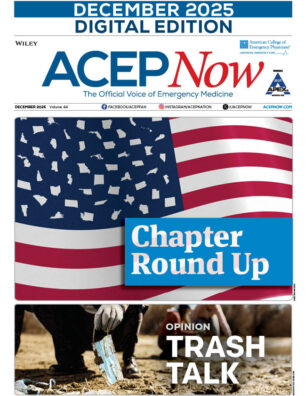Ohio’s emergency department (ED) guidelines for reducing inappropriate prescribing are linked to a drop in opioid dispensing, researchers say.
The guidelines, implemented in 2012, encourage emergency physicians to determine whether a patient has other prescriptions for controlled medications; to prescribe no more than a three-day supply; and to refer patients to a primary care provider or specialist for evaluation, treatment and follow-up of continuing pain, according to a May 23 online report in Annals of Emergency Medicine by Dr. Scott Weiner of Brigham and Women’s Hospital in Boston and colleagues.
Between 2010 and 2014, nearly 2.8 million prescriptions were written by 1,855 emergency physicians for the five most commonly prescribed opioids: hydrocodone, oxycodone, tramadol, codeine, and hydromorphone.
Opioid prescriptions were already decreasing by 0.31 percent per month during the pre-guideline period. Guideline implementation was associated with a 12 percent reduction in total monthly opioid prescriptions, a 17 percent reduction in the level of morphine mg-equivalents per month, and an estimated reduction of 11.2 percent on monthly prescriptions for more than a three-day supply. Various reductions also were seen in prescriptions for each of the five opioids studied.
Overall, the guidelines were associated with an additional decline of 0.9 percent in trend relative to the preguideline trend.
“It’s impossible to tell from prescription drug monitoring program data if a prescription was ‘inappropriate’ or not,” Dr. Weiner acknowledged, because the databases don’t contain the reason for the opioid prescription or other clinical data.
However, he told Reuters Health by email, prescriptions for more than three days could be considered inappropriate,” since most acute pain does not require more than three days of medication.” Another marker of appropriateness could be co-prescribing opioids and benzodiazepines, he said, “as we know this combination can greatly increase overdose risk.”
“Finally, it is usually inappropriate to prescribe long-acting/extended-release opioids from the ED, and this is also discouraged by the Ohio guidelines. We know from our prior recent research that only about 1 percent of emergency physician prescriptions are for this type of opioid, so this is already quite low.”
Dr. Weiner added that emergency physicians are responsible for only a small percentage of opioid prescriptions – only 5 percent overall in Ohio, and only 1.2 percent of the morphine equivalents given. Therefore, he said, “it is imperative that other specialties adopt and use similar guidelines.”
Emergency physician Dr. Michael Fitch of Wake Forest Baptist Medical Center in Winston-Salem, North Carolina, told Reuters Health that while he agrees with the findings, “it is important to understand that this type of study does not necessarily prove a clear cause and effect between the guidelines and the smaller numbers of prescriptions over time.”
“It does identify an association . . . and provides some evidence that the guidelines may have contributed to a larger decrease in numbers of prescriptions,” he observed. “However, the study (could not) determine whether any of the prescriptions that were written actually followed the guidelines, and there is no way to know whether individual prescriptions were given for appropriate medical indications either before or after the guidelines were developed.”
Although the guidelines “can help guide medical providers while still permitting appropriate medical decisions to be based on each individual patient encounter,” he added, “guidelines that focus on only one medical specialty . . . have a limited ability to have a significant impact on the larger public health issues regarding opioid use in our country. We need to continue looking for opportunities across all medical specialties for ways in which we can use these medications responsibly,” Dr. Fitch concluded.
Dr. Stephen Thornton, medical director at the University of Kansas Health System Poison Control Center in Kansas City, agree that the study can only show correlation, not causation. Decreases in prescriptions “might be due to the state guidelines or due to the national pushback against indiscriminate opioid use,” he told Reuters Health.
“Either way,” he said, “it is another piece of evidence that the tide may be turning against the opioid epidemic. There are clearly times when prescribing an opioid is appropriate but it should not be a first-line agent,” he added.
Pages: 1 2 | Multi-Page




No Responses to “ED Opioid Guidelines Tied to Fewer Prescriptions in Ohio”